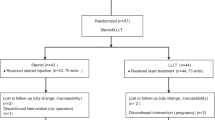Abstract
Carpal tunnel syndrome (CTS) is an entrapment neuropathy of the median nerve at the wrist. It is one of the most common peripheral nerve disorders. The cause of idiopathic CTS remains unclear. The diagnosis of CTS is still mainly clinical. Open carpal tunnel release is the standard treatment. The present study was conducted to evaluate the effectiveness of low level laser treatment (LLLT) for CTS in comparison to the standard open carpal tunnel release surgery. Out of 54 patients, 60 symptomatic hands complaining of CTS were divided into two equal groups. Group A, was subjected to LLLT by Helium Neon (He–Ne) laser (632.8 nm), whereas group B was treated by the open approach for carpal tunnel release. The patients were evaluated clinically and by nerve conduction studies (NCSs) about 6 months after the treatment. LLLT showed overall significant results but at a lower level in relation to surgery. LLLT showed significant outcomes in all parameters of subjective complaints (p ≤ 0.01) except for muscle weakness. Moreover, LLLT showed significant results in all parameters of objective findings (p ≤ 0.01) except for thenar atrophy. However, NCSs expressed the same statistical significance (p ≤ 0.01) after the treatment by both modalities. LLLT has proven to be an effective and noninvasive treatment modality for CTS especially for early and mild-to-moderate cases when pain is the main presenting symptom. However, surgery could be preserved for advanced and chronic cases. Refinement of laser tools and introduction of other wavelengths could make LLLT for CTS treatment a field for further investigations.
Similar content being viewed by others
References
Ahn DS, Yoon ES, Koo SH, Park SH (2000) A prospective study of the anatomic variations of the median nerve in the carpal tunnel in Asians. Ann Plast Surg 44:282–287
Bland JDB (2000) The value of the history in the diagnosis of carpal tunnel syndrome. J Hand Surg 25B:445–450
Bland JDB (2001) Do nerve conduction studies predict the outcome of carpal tunnel decompression? Muscle Nerve 24:935–940
Bland JDB (2005) Carpal tunnel syndrome. Curr Opin Intern Med 4(6):578–582
Boz C, Ozmenoglu M, Altunayoglu V (2004) Individual risk factors for carpal tunnel syndrome: an evaluation of body mass index, wrist index and hand anthropometric measurements. Clin Neurol Neurosurg 106:294–299
El Miedany YM, Aty SA, Ashour S (2004) Ultrasonography versus nerve conduction study in patients with carpal tunnel syndrome: substantive or complementary tests? Rheumatology (Oxford) 43:887–895
Ettema AM, Amadio PC, Cha SS, Harrington JR, Harris AM, Offord KP (2006) Surgery versus conservative therapy in carpal tunnel syndrome in people aged 70 years and older. Past Reconstr Surg 118(4):947–958
Geoghegan JM, Clark DI, Bainbridge LC (2004) Risk factors in carpal tunnel syndrome. J Hand Surg 29B:315–320
Hirata H, Nagakura T, Tsujii M (2004) The relationship of VEGF and PGE2 expression to extracellular matrix remodeling of the tenosynovium in the carpal tunnel syndrome. J Pathol 204:605–612
Hirata H, Tsujii M, Yoshida T (2005) MMP-2 expression is associated with rapidly proliferative arteriosclerosis in the flexor tenosynovium and pain severity in carpal tunnel syndrome. J Pathol 205:443–450
Irvine J, Chong SL, Amirjani N, Chan KM (2004) Double-blind randomized controlled trial of low-level laser therapy in carpal tunnel syndrome. Muscle Nerve 30:182–187
Kamolz LP, Beck H, Haslik W (2004) Carpal tunnel syndrome: a question of hand and wrist configurations? J Hand Surg 29B:321–324
Kujawa J, Zavodnik L, Zavodnik I, Bryszewska M (2003) Low intensity near infrared laser radiation induces changes of acetylcholine esterase activity of human erythrocytes. Lasers Surg Med 21(6):351–355
Matson E, Perira AN, Eduardo P, Marques MM (2002) Effect of low power laser irradiation on cell growth and procollagen synthesis in cultured fibroblasts. Lasers Surg Med 31(4):263–267
Naeser MA, Kyumg AEK, Hahn MD, Lieberman BE, Kenneth F, Branco MA (2002) Carpal tunnel syndrome pain treated with low level laser and microamperes transcutaneous electric nerve stimulation. Arch Phys Med Rehabil 83:978–988
Nora DB, Becker J, Ehler JA, Gomes I (2004) Clinical feature of 1,039 patients with neurophysiological diagnosis of carpal tunnel syndrome. Clin Neurol Neurosurg 107:64–69
Rodner CM, Katarincic J (2006) Open carpal tunnel release. Tech Orthop 21(1):3–11
Schmelzer RE, Rocca GJD, Caplin DA (2006) Endoscopic carpal tunnel release: a review of 753 cases in 486 patients. Plast Reconstr Surg 117(1):177–185
Scholten RJPM, de Krom MCTFM, Bertelsmann FW, Bouter LM (1997) Variation in the treatment of carpal tunnel syndrome (Letter). Muscle Nerve 20:1334–1335
Witt JC, Hentz JG, Stevens JC (2004) Carpal tunnel syndrome with normal nerve conduction studies. Muscle Nerve 29:515–522
Acknowledgment
The authors thank Mrs. Reham Shahin for her effort during the primary conduction of LLLT for CTS. Finally, we express our appreciation for the staff of the Clinical Neurophysiology unit, Cairo University, for their cooperation during NCSs.
Author information
Authors and Affiliations
Corresponding author
Rights and permissions
About this article
Cite this article
Elwakil, T.F., Elazzazi, A. & Shokeir, H. Treatment of carpal tunnel syndrome by low-level laser versus open carpal tunnel release. Lasers Med Sci 22, 265–270 (2007). https://doi.org/10.1007/s10103-007-0448-8
Received:
Accepted:
Published:
Issue Date:
DOI: https://doi.org/10.1007/s10103-007-0448-8




